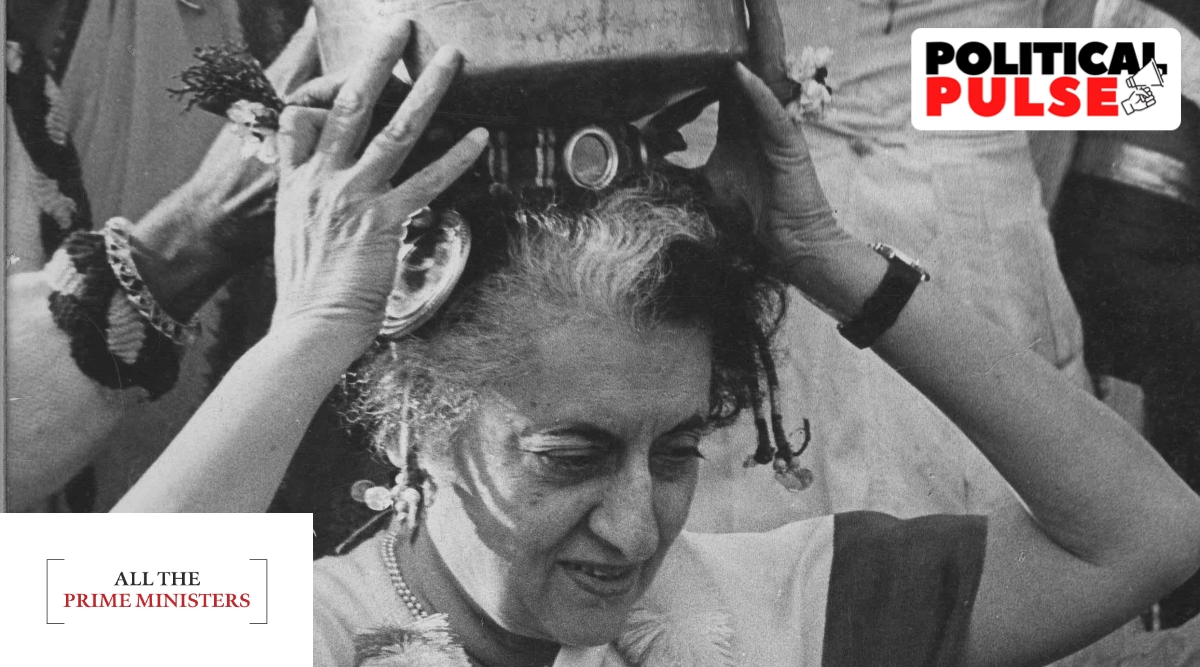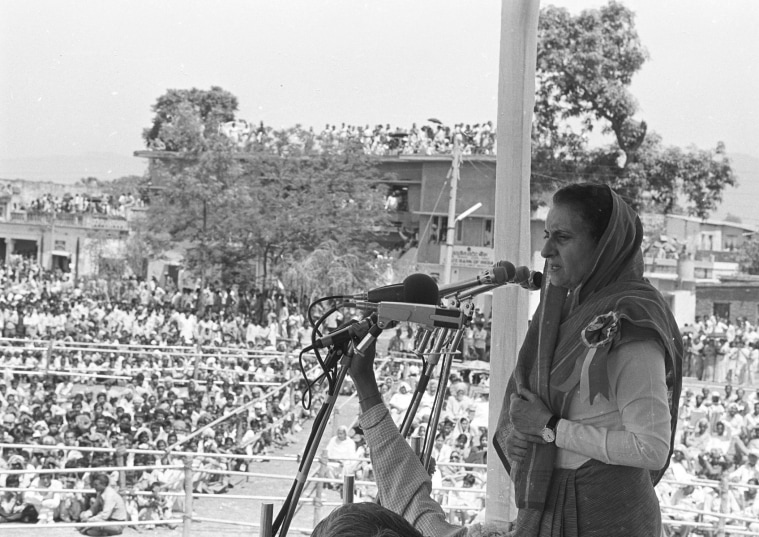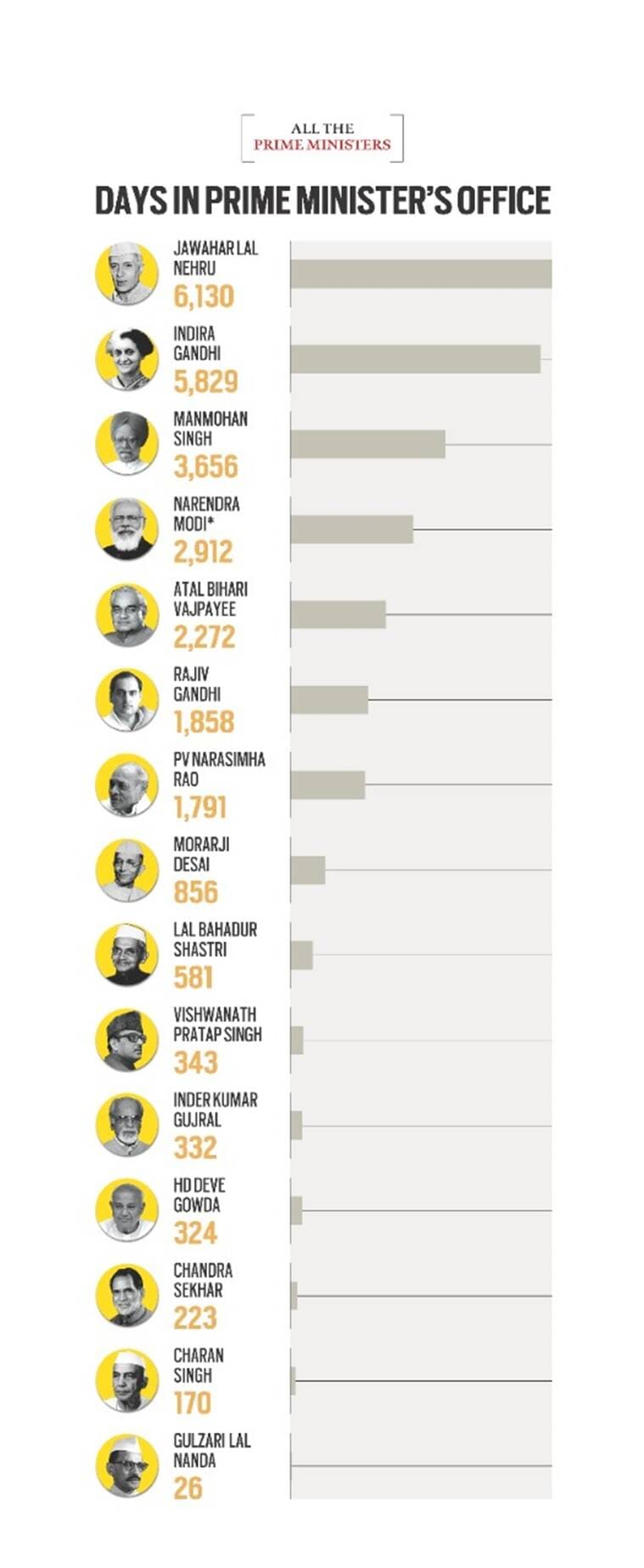 Indira Gandhi with Rajasthani 'Gagri' head at Teen Murti house on 29-1-1982. (Express Archives)
Indira Gandhi with Rajasthani 'Gagri' head at Teen Murti house on 29-1-1982. (Express Archives)Prime Minister Narendra Modi, who has completed eight years in office, recently hinted that he was ready for a third term. Speaking virtually at a meeting in Bharuch where beneficiaries of various central government schemes were assembled, he said a “very senior” Opposition leader had once asked him what else was left for him to accomplish after becoming the PM twice. Modi said he would not rest till “100 per cent” coverage of government schemes was achieved in the country.
Modi, 71, is first PM so far to be born after Independence. In the course of over seven decades, the country has seen 15 Prime Ministers, over a journey marked with social, political and economic changes. The Indian Express looks at India’s parliamentary democracy through the tenures of its PMs.
***********
Indira Gandhi, the fourth Prime Minister of India, was the country’s first – and, till date, only – woman PM. The daughter of India’s first and longest-serving PM Jawaharlal Nehru, Gandhi served as the PM for four terms for a period spanning a total of 5,829 days, becoming the second-longest serving PM so far.
Best of Express Premium
She was first sworn in as the PM on January 24, 1966, taking charge from Gulzari Lal Nanda, who held the office for 13 days in the interim period following the passing away of the incumbent PM Lal Bahadur Shastri on January 11, 1966.
During an 11-year-2-month period, from January 24, 1966 to March 24, 1977, Gandhi remained the PM for three consecutive terms. Her fourth prime ministerial stint encompassed four years, nine months and 18 days, starting from January 14, 1980 till October 31, 1984, when she was assassinated.
Gandhi took the plunge into electoral politics soon after Nehru’s demise. She joined the Shastri Cabinet as the information and broadcasting minister in early July 1964 and got elected to the Rajya Sabha in August 1964. She remained a member of the Upper House for about three years.
Making her debut in the general elections to the 4th Lok Sabha in 1967, Gandhi contested from Rae Bareli and defeated an independent candidate by 91,703 votes. Although she led the Congress to a victory, the polls saw a decline in the party’s performance as compared to its showing in the elections to the first, second and third Lok Sabha during the Nehru era.
Seven national parties – the Congress, Bharatiya Jana Sangh (BJS), Communist Party of India (CPI), Communist Party of India-Marxist (CPM), Praja Socialist Party (PSP), Samyukta Socialist Party (SSP) and Swatantra Party (SWA) – 14 state parties and 4 registered parties fought the 1967 polls. The Congress contested 516 constituencies and got 283 seats with a 40.78 per cent vote share as compared to its tally of 361 seats with 44.72 per cent votes garnered in the 1962 elections.
Although the Congress had fielded its candidates in all of the then 25 states and Union Territories (UTs), it could not win any seat in three UTs – Manipur, Chandigarh and Goa, Daman and Diu. This was the first general elections that saw the Opposition parties gaining some ground. While the SWA came second behind the Congress, winning 44 seats, the BJS (35 seats), CPI (23) and CPM (19) came second, third and fourth respectively.
 Indira Gandhi addressing a public rally at Paonta Saheb. (Express Archives)
Indira Gandhi addressing a public rally at Paonta Saheb. (Express Archives) Two years later, there was a split in the Congress, with then party president S Nijlingappa expelling Gandhi from it. She was forced to get a new election symbol, a cow with a calf, for her splinter outfit. She also opted for fresh general elections before completing her full tenure that saw several major moves such as the nationalisation of banks.
In the 1971 elections (for the 5th Lok Sabha), 8 national parties – Gandhi’s Congress (Requisitionists), Congress (Organisation), BJS, CPI, CPM, PSP, SSP and SWA – 17 state parties and 28 registered parties were in the fray.
The Gandhi-led Congress party swept the polls, winning 352 seats out of 441 constituencies it had fought. The tallies of the Opposition parties like the BJS and the SWA saw a dip in their tallies.
Gandhi was re-elected from Rae Bareli – this time with a bigger margin. She defeated the SSP’s Raj Narain by 1,11,810 votes. However, the result of this election was declared null and void by the Allahabad High Court in 1975.
It was during her third term as the PM that India defeated Pakistan in the 1971 war that led to the creation of Bangladesh. Her tenure, however, later also saw major public campaigns like the “JP Movement” and Gujarat’s “Navnirman Andolan”.
Days after the high court set aside Gandhi’s election from Rae Bareli, she declared Emergency on June 26, 1975, which remained in force for 21 months in one of the most controversial periods of Independent India that saw subversion of fundamental rights and liberties.
The 1977 Lok Sabha polls were held coinciding with the expiry of the Emergency, in which the ruling Congress was routed. Gandhi contested from Rae Bareli and lost to Raj Narain with a margin of 55,202 votes. The Congress managed to get only 154 out of 492 seats where the party fielded its candidates. An amalgam of the Opposition parties, the Janata Party, won a majority in the polls and its leader Morarji Desai became the first non-Congress PM.
Gandhi staged a comeback in the elections to the 7th Lok Sabha in 1980. She contested from two constituencies and won from both seats. In Medak (Andhra Pradesh), she defeated S Jaipal Reddy by 2,19,224 votes. However, she resigned from this constituency and chose to retain Rae Bareli, where she defeated her arch rival Raj Narain by 1,73,654 votes. Her party, Congress (I), won by a landslide, winning 353 of 492 seats it contested. The entire Opposition was decimated in the elections. Gandhi again took over as the PM and remained in the office till October 31, 1984, when she was assassinated.
 A look at the tenure of India’s prime ministers.
A look at the tenure of India’s prime ministers. - The Indian Express website has been rated GREEN for its credibility and trustworthiness by Newsguard, a global service that rates news sources for their journalistic standards.

